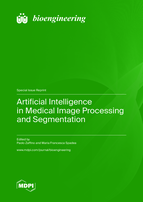Artificial Intelligence in Medical Image Processing and Segmentation
A special issue of Bioengineering (ISSN 2306-5354). This special issue belongs to the section "Biosignal Processing".
Deadline for manuscript submissions: closed (31 May 2023) | Viewed by 44999
Special Issue Editors
Interests: medical image processing; radiotherapy; image guided surgery; artificial intelligence
Special Issues, Collections and Topics in MDPI journals
Interests: radiation therapy; biomedical imaging; 3D image processing; biomedical engineering
Special Issues, Collections and Topics in MDPI journals
Special Issue Information
Dear Colleagues,
In recent years, Artificial Intelligence (AI) has deeply revolutionized the field of medical image processing. In particular, image segmentation has been the task which mostly benefited from such an innovation.
This boost led to great advancements in the translation of AI algorithms from the laboratory to real clinical practice, in particular for computer-aided diagnosis and image-guided surgery.
As a result, the first medical devices relying on AI algorithms to treat or diagnose patients were recently introduced to the market.
Giant leaps have been achieved, but more has to be done.
We are pleased to invite you to submit your work to this Special Issue, which will focus on the cutting-edge developments of AI applied to the medical image field.
The journal will be accepting contributions (both original articles and reviews) mainly centered on the following topics:
- Medical image segmentation;
- AI-based medical image registration;
- Medical image recognition;
- Patient/treatment stratification based on AI image processing;
- Synthetic medical image generation;
- Image-guided surgery/radiotherapy based on AI;
- Radiomics;
- Explainable AI in medicine.
Dr. Paolo Zaffino
Prof. Dr. Maria Francesca Spadea
Guest Editors
Manuscript Submission Information
Manuscripts should be submitted online at www.mdpi.com by registering and logging in to this website. Once you are registered, click here to go to the submission form. Manuscripts can be submitted until the deadline. All submissions that pass pre-check are peer-reviewed. Accepted papers will be published continuously in the journal (as soon as accepted) and will be listed together on the special issue website. Research articles, review articles as well as short communications are invited. For planned papers, a title and short abstract (about 100 words) can be sent to the Editorial Office for announcement on this website.
Submitted manuscripts should not have been published previously, nor be under consideration for publication elsewhere (except conference proceedings papers). All manuscripts are thoroughly refereed through a single-blind peer-review process. A guide for authors and other relevant information for submission of manuscripts is available on the Instructions for Authors page. Bioengineering is an international peer-reviewed open access monthly journal published by MDPI.
Please visit the Instructions for Authors page before submitting a manuscript. The Article Processing Charge (APC) for publication in this open access journal is 2700 CHF (Swiss Francs). Submitted papers should be well formatted and use good English. Authors may use MDPI's English editing service prior to publication or during author revisions.
Keywords
- medical image processing
- image segmentation
- computer-aided diagnosis
- image guided surgery
- artificial intelligence








